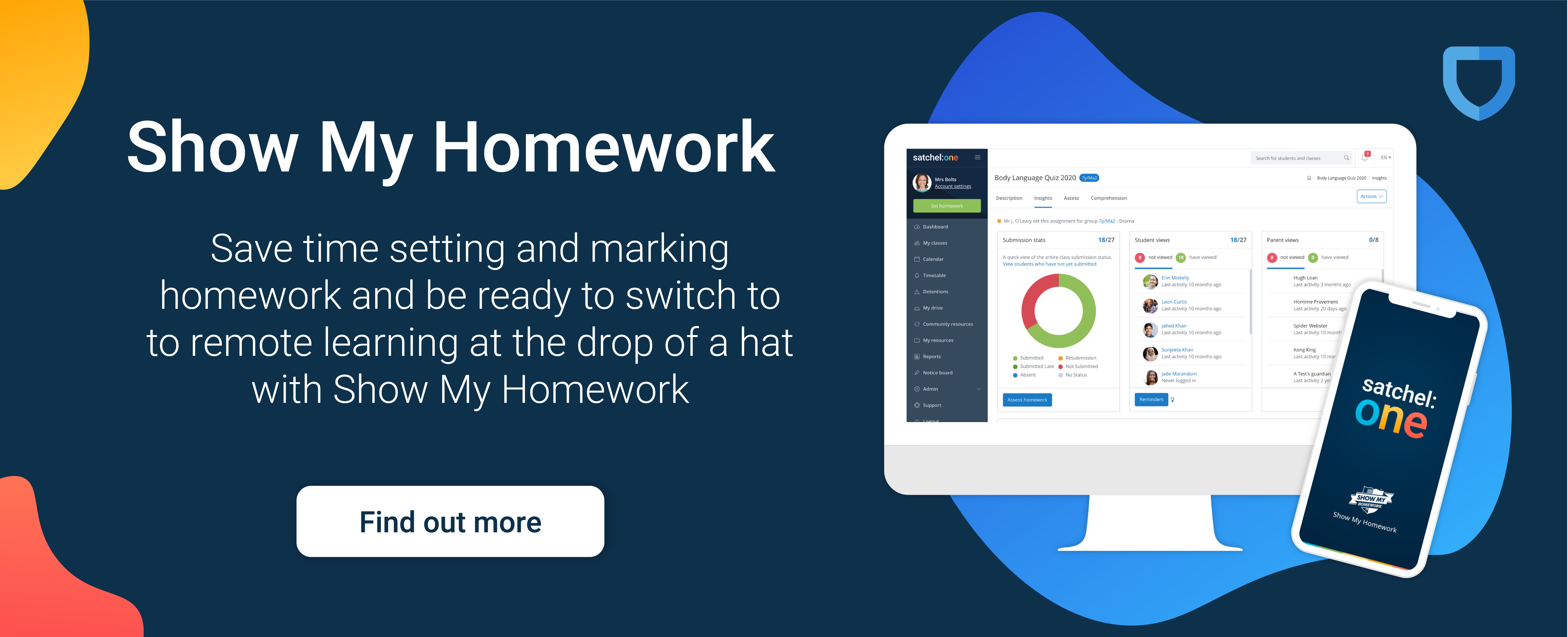Author: Ben Greenwood
Posted: 09 Apr 2021
Estimated time to read: 7 mins
That’s right, we’ve all successfully weathered lockdown 3.0 and everyone is back in school. But things have changed since students were last in the classroom.
Schools might have been more prepared for this one, but both students and teachers experienced some weariness with constant online learning and teaching.
We may have minimised learning loss this time, but students still weren’t able to learn quite the same way they would in class, and supporting those who need it has been hard for teachers.
In this blog, we’ll explore three of schools’ biggest challenges from the most recent lockdown, see how they tackled them and then assess how lessons learnt during these prolonged periods of distance learning might change some aspects of teaching for good.
Challenges schools faced during lockdown 3.0
Schools faced a whole heap of challenges this lockdown. Some they had become used to, some new ones. We’ll focus on the challenges that had the most significant impact, and will continue to impact the way schools run in the future.
- Distance learning fatigue
After two lockdowns, it’s fair to say that any novelty was well and truly gone for 3.0. In fact, as the PM announced the third lockdown on a dark and dreary January evening, it couldn’t have been further from the sense of historical significance that the first summer lockdown gave us.
By now the constant online learning has suffered a similar loss of interest too. The freedom associated with being able to do school work from the comfort of home may have given a little boost in engagement from students to begin with. But two lockdowns later and distance learning fatigue had well and truly set in.
- Learning loss
The first lockdown saw some substantial learning loss across our schools. So much so that the government had to announce it’s catch-up fund to help schools close the attainment gap that had opened up.
During the most recent lockdown, schools had better distance learning solutions in place, so the impact wasn’t as great, but there was still a significant loss in learning that stemmed from being outside of the classroom.
This is worrying for the education sector, as figures already show disparity between privileged and less privileged students. Learning loss only broadens that gap.
- Welfare issues
Finally, home welfare issues have always been a difficult part of teaching. Even in the classroom, knowing when interventions are necessary and how to approach them is a tricky task.
Eliminating any in-person contact with students made this almost impossible for teachers without some kind of system in place. An increase in workload, stemming from changes that happened due to the pandemic, also meant that staff didn’t have the time required to interact fully with families that way they might have.
Overall, all lockdowns saw a rise in child abuse accross the board, with a rise of 1493% in the first lockdown. This meant that in the subsequent lockdowns, teachers had even more of a task on their hands.

How schools overcame these challenges
It took a lot of hard work, under an immense amount of pressure, but after some time in lockdown, teachers began to evolve in the way they worked. With new innovative developments from edtech companies, some funding from the government and commitment from school leaders, schools managed to overcome these challenges against the odds
- Innovative ways to teach and learn
After three lockdowns of video lessons and remote work, both students and teachers are ready to get back in the classroom. But let's not forget the innovative ways to learn that our teachers pioneered during this period.
Keeping students engaged was no easy task but there were some great ideas out there for making learning a little more than watching videos at home.
- Interactive quizzes - quizzes like Kahoot and AhaSlides that students join live are great for stoking that competitive spirit! They also allow teachers to identify which students are struggling and need more support.
- Multiplayer educational games - again, a little competition always helps get students in the zone. Games are a good way to break up regular schoolwork and keep things fun.
- Podcast micro lessons - distance learning fatigue really affected students’ ability to concentrate. Micro lessons provide short, concentrated lessons on specific topics, meaning concentration spans won’t be tested and increasing the likelihood that information is actually absorbed.
- Physical activities to do at home - Joe Wicks is a great example of this, but it wasn’t just PE. Scavenger hunts, online school plays and more innovative ways to use Zoom were discovered over lockdown.
- Catch-up learning
Catch-up learning initiatives have helped begin to bridge the gap, but for many students there is still quite a way to go. Schools had to decide how to use their catch-up grants wisely, as the funding wasn’t as substantial as many expected.
But through this, tales of teachers holding their own tutoring sessions and schools building banks of teacher led videos for catch up learners spread. Schools took the problem into their own hands and began clawing back lost attainment.
- Smarter interventions
Despite the difficulty in keeping students safe remotely, teachers persisted as much as they could, reaching out to students who needed extra support. They opened more communication channels to accommodate students who needed help.
This meant more contact either via calls or email to check in with students at risk. The increased use of online platforms and social media also gave students more ways to discreetly speak to teachers or wellbeing staff.
What does this tell us about the future of education?
We may be emerging from lockdown, as the PM says, ‘for good’, but this doesn’t mean that we should toss the last year away like a used face mask. On the contrary, the pandemic has forced us to innovate in areas we never thought we would need to. And the results have been intriguing. But how else might the events of the last year mould our future?
- Teachers will be the driving force in education’s future
Teachers have been on the frontline since the beginning of the pandemic. They’ve weathered the storms of closure and reopening multiple times and have had to field any challenges that came their way during an extremely worrying and stressful time.
As a result, many teachers have learned new teaching methods and many have become far more tech savvy. This is going to cause a hugely positive change to our classrooms, as teachers embrace tech as a dynamic learning tool even more.
Many teachers’ innovations in the way they teach came about due to necessity. Things like flexible learning, video lessons, blended learning and interactive quizzes are all things that were necessary during the pandemic. But seeing just how engaged students are in these methods has convinced schools to take them into post-pandemic classrooms.
The changes that classroom teachers have made to the way students learn will be the most significant in the future. Armed with the knowledge of the way their students work best, they will continue to evolve their teaching going forward.
- Flexible and remote working could become the norm
The pandemic highlighted a number of issues that were already present in our society. Teacher workload has long been the plague of the British teacher. Lockdown and new regulations shone a spotlight on these issues.
Teachers could now be looking at a permanent shift in the way they work, with more scope for working from home. Flexible working patterns are now a possibility after they became a necessity during the pandemic.
With a culture that sees countless teachers take stress-related illness leave, cut hours or leave the profession altogether, something has to give. Flexible working could provide teachers with time outside of school to plan, mark and even teach.
Many schools will now be able to use the amazing work teachers did whilst working remotely as evidence that it is possible to continue being productive and delivering a complete curriculum from home.
The benefits of working remotely include:
- Less distractions - easier to concentrate on high focus tasks
- Less time spent commuting - more time for personal development and training
- Better teacher wellbeing - which leads to stronger school culture and higher education standards.
- We need to do everything we can to avoid learning loss during closures
Before the pandemic, heavy snow or floods in the UK would mean a day-off for students and teachers. But now schools have been forced to implement robust distance learning plans procedures for the pandemic, it’s likely that they’ll want to put these capabilities to use in other circumstances.
And with students having missed so much school already, this can only be a good thing. As the classic teacher’s attendance adage goes, ‘missing 17 days of school can make a student lose a whole grade’. For the foreseeable future, schools are going to be much more vigilant with attendance to ensure that their students are catching up with the weeks and months they lost in 2020/21.
- Schools will take a more holistic approach to learning
The negative effects of multiple lockdowns has had a huge effect on at-risk students. The significance of home life in a students performance has become much more apparent. Due to ths, we’re likely to see more schools commit further to holistic teaching and learning.
Ensuring that students are mentally and emotionally ready to learn effectively is just as important as the curriculum material itself. As we start to tackle the negative effects lockdown has had on student mental health, we should strive to protect it more thoroughly in the future.



